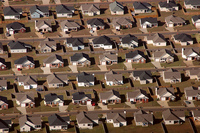Yesterday’s suburbia tomorrow
Freakonomics’ latest quorum discusses everyone’s favorite topic in the era of high gas prices: the future of suburbs. After the predictable quotes from Kunstler (“The suburbs have three destinies… as materials salvage, as slums, and as ruins”) comes Freehold, NJ administrator Thomas Antus, who thinks development will make taxes spiral out of control while developers all move to Wyoming. Antus appears to think that if only he can stop anyone from building in his town, life will continue to be idyllic—for the residents of his town, at least.
The third contributor is the first really sensible one. Jan Brueckner, economics professor at UC Irvine, writes,
“If [gentrification] continues in a significant way, large numbers of suburban households looking for urban stimulation may end up switching places with minority central-city dwellers, stirring the ethnic pot in both places.”
That’s already starting to happen, and that’s why we need more affordable housing and to simply build more urban areas to enable people of all incomes keep living in one if they want to. Matt Yglesias writes more on the same topic:
Higher energy costs will … make urban living more attractive than it currently is now. In a totally unregulated market, that would lead central cities and inner suburbs alike to become denser, with the inner suburbs taking on more of the characteristics of urban areas (as parts of Arlington and Montgomery counties already do in the DC area) … But of course real estate and development are anything but unregulated markets.
The past half century or so has been dominated by rules about maximum lot occupancy and minimum lot size, parking requirements, and floor area ratio caps that were designed to produce something like the suburbs as we know them. Insofar as we keep those rules, the future will resemble the present. Insofar as we change them, things will change.
One example of these rules: a ban on clotheslines. According to Grist (via Free State Politics), in one unnamed Maryland town, “a neighbor complained that [a resident’s environmentally friendly] clothesline ‘makes our community look like Dundalk,’ a low-income part of Baltimore.”
Keeping out the poor, and even the appearance of the poor, was and remains a goal of some suburban towns’ zoning and other rules. In Herndon, one Councilman wants to ban locking bicycles to signposts in an effort to keep out day laborers. If we only allow single-family houses on large lots and make the town unfriendly to anyone without a car, some think, it’ll be too expensive for those who don’t look like us to live here. That thinking is alive and well with this Herndon Councilmember, just as in Just Up the Pike’s recent experience in Burtonsville.
Is this the motivation behind McLean residents still fighting density in Tysons? Gerry Connolly is still firmly in favor of more urban redevelopment despite some resistance from suburban-minded staff planners. Tysons Land Use Task Force chairman Clark Tyler, too, is committed to the changes, arguing, “If you do what you’ve always done, you’re going to get what you always got.”
That’s a good attitude in general. High energy costs, frustrating commutes, segregation, endless traffic and environmental destruction are what we’ll get if we do what we’ve always done.

